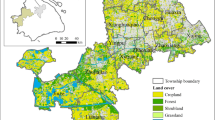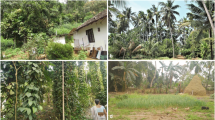Abstract
There is a considerable challenge to meeting the Sustainable Development Goals (SDGs) of ending poverty and maintaining ecosystems’ function in rural areas, largely due to that the rural people’s livelihood relied heavily on fragile ecosystems. China is ambitious to solve this issue by enacting economic stimulus policies such as ecological protection compensation and payment for ecosystem services (ESs). However, these interventions are generally based on stockholders’ willingness and lack of scientific basis. Here, we firstly combined InVEST model and social-economic data to evaluate the ecosystem services supply and demand (ESSD), by taking 25 key counties to receive assistance in pursuing rural revitalization in Sichuan province as the study cases. The coupling coordination degree model was then employed to measure the coordination relationship of ESSD. Finally, the driving factors were analyzed based on correlation analysis and stepwise regression method. The results showed that all ESs, except carbon sequestration, were oversupplied with significant spatial heterogeneity. From 2000 to 2020, the supply of all ESs increased, in which the food production had the most notable increase ratio amounting to 48.20%, while the demand of water retention and air purification decreased substantially. Due to the inconsistency between cultivated land area and population changes, significant spatial heterogeneity existed in the coordination relationship of food production. The counties with the highest and the lowest annual average coordination index were Yanyuan (0.9950) and Rangtang (0.1208), respectively. The rural employees and the agricultural gross output value were the key positive factors influencing the quantity and coordination of ESSD, while ecological compensation and financial expenditure had no significant impact, further indicating that these policies were not linked to the performance of ecosystems’ function. Finally, policy implications were raised. This study provides a scientific framework for enacting the interventions towards ecological sustainability and poverty ending from ESSD perspective.










Similar content being viewed by others
Data availability
The datasets used and/or analyzed during the current study are available from the corresponding author on reasonable request.
Abbreviations
- AP:
-
Air purification
- CCD:
-
Coupling coordination degree
- CO2 :
-
Carbon dioxide
- CS:
-
Carbon sequestration
- ESDR:
-
Ecological supply–demand ratio
- ESs:
-
Ecosystem services
- ESSD:
-
Ecosystem services supply and demand
- FP:
-
Food production
- SC:
-
Soil conservation
- SDGs:
-
Sustainable Development Goals
- WR:
-
Water retention
References
Arunyawat S, Shrestha RP (2018) Simulating future land use and ecosystem services in Northern Thailand. J Land Use Sci 13:146–165. https://doi.org/10.1080/1747423X.2018.1496157
Bai Y, Chen Y, Alatalo JM et al (2020) Scale effects on the relationships between land characteristics and ecosystem services- a case study in Taihu Lake Basin, China. Sci Total Environ 716. https://doi.org/10.1016/J.SCITOTENV.2020.137083
Borucke M, Moore D, Cranston G et al (2013) Accounting for demand and supply of the biosphere’s regenerative capacity: The National Footprint Accounts’ underlying methodology and framework. Ecol Indic 24:518–533. https://doi.org/10.1016/J.ECOLIND.2012.08.005
Burkhard B, Kroll F, Nedkov S, Mueller F (2012) Mapping ecosystem service supply, demand and budgets. Ecol Indic 21:17–29
Chaplin-Kramer R, Sharp RP, Weil C et al (2019) Global modeling of nature’s contributions to people. Science (1979) 366:255–258. https://doi.org/10.1126/SCIENCE.AAW3372
Chen W, Chi G (2022) Spatial mismatch of ecosystem service demands and supplies in China, 2000–2020. Environ Monit Assess 194:1–18. https://doi.org/10.1007/S10661-022-09981-Y/TABLES/5
Chen J, Gao M, Cheng S et al (2020) County-level CO2 emissions and sequestration in China during 1997–2017. Sci Data 7. https://doi.org/10.1038/S41597-020-00736-3
Costanza R (2008) Ecosystem services: multiple classification systems are needed. Biol Conserv 141:350–352
Das A, Das M, Houqe R, Pereira P (2023) Mapping ecosystem services for ecological planning and management: a case from a tropical planning region, Eastern India. Environ Sci Pollut Res 30:7543–7560. https://doi.org/10.1007/S11356-022-22732-3
de Groot RS, Wilson MA, Boumans RMJ (2002) A typology for the classification, description and valuation of ecosystem functions, goods and services. Ecol Econ 41:393–408. https://doi.org/10.1016/S0921-8009(02)00089-7
Díaz S, Demissew S, Carabias J et al (2015) The IPBES Conceptual Framework - connecting nature and people. Curr Opin Environ Sustain 14:1–16. https://doi.org/10.1016/J.COSUST.2014.11.002
Fisher B, Kerry Turner R (2008) Ecosystem services: classification for valuation. Biol Conserv 141:1167–1169
Fisher JA, Patenaude G, Giri K et al (2014) Understanding the relationships between ecosystem services and poverty alleviation: a conceptual framework. Ecosyst Serv 7:34–45. https://doi.org/10.1016/J.ECOSER.2013.08.002
Gao X, Wang J, Li C et al (2021) Land use change simulation and spatial analysis of ecosystem service value in Shijiazhuang under multi-scenarios. Environ Sci Pollut Res 28:31043–31058. https://doi.org/10.1007/S11356-021-12826-9
González-García A, Palomo I, González JA et al (2020b) Quantifying spatial supply-demand mismatches in ecosystem services provides insights for land-use planning. Land Use Policy 94. https://doi.org/10.1016/j.landusepol.2020.104493
Li S, Shen J, Sun F et al (2022) Quantitative evaluation of ecological compensation policies for the watershed in China: based on the improved Policy Modeling Consistency Index. Environ Sci Pollut Res 29:66659–66674. https://doi.org/10.1007/S11356-022-20503-8
Liu N, Liu C, Xia Y, Da B (2018) Examining the coordination between urbanization and eco-environment using coupling and spatial analyses: a case study in China. Ecol Indic 93:1163–1175. https://doi.org/10.1016/J.ECOLIND.2018.06.013
Liu X, Jiang Y, Zheng X et al (2023) Moving towards co-benefits of hydropower: ecological efficiency evaluation based on LCA and DEA. Environ Impact Assess Rev 102:107208. https://doi.org/10.1016/J.EIAR.2023.107208
Liu J, Mooney H, Hull V et al (2015) Systems integration for global sustainability. Science (1979) 347. https://doi.org/10.1126/SCIENCE.1258832
Liu X, Xiao S, Pan H et al (2022a) Optimizing hydropower plants based on carbon-water-energy-ecosystem nexus. Energy Convers Manag 270. https://doi.org/10.1016/j.enconman.2022.116191
Liu X, Zheng X, Wu L et al (2022b) Techno-ecological synergies of hydropower plants: insights from GHG mitigation. Sci Total Environ 853. https://doi.org/10.1016/j.scitotenv.2022.158602
Lorilla RS, Kalogirou S, Poirazidis K, Kefalas G (2019) Identifying spatial mismatches between the supply and demand of ecosystem services to achieve a sustainable management regime in the Ionian Islands (Western Greece). Land Use Policy 88. https://doi.org/10.1016/j.landusepol.2019.104171
Meng Y, Liu M, Guan X, Liu W (2019) Comprehensive evaluation of ecological compensation effect in the Xiaohong River Basin, China. Environ Sci Pollut Res 26:7793–7803. https://doi.org/10.1007/S11356-019-04208-Z
Millennium Ecosystem Assessment (Program) (2005) Ecosystems and human well-being : synthesis. Island Press
Naidoo R, Balmford A, Costanza R et al (2008) Global mapping of ecosystem services and conservation priorities. Proc Natl Acad Sci U S A 105:9495–9500. https://doi.org/10.1073/PNAS.0707823105
Ouyang Z, Zheng H, Xiao Y et al (2016) Improvements in ecosystem services from investments in natural capital. Science (1979) 352:1455–1459. https://doi.org/10.1126/SCIENCE.AAF2295
Raudsepp-Hearne C, Peterson GD, Teng M et al (2010) Untangling the environmentalist’s paradox: why is human well-being increasing as ecosystem services degrade? Bioscience 60:576–589. https://doi.org/10.1525/BIO.2010.60.8.4
Sachs J, Schmidt-Traub G, Kroll C, Lafortune G, Fuller G, Woelm F (2020) The sustainable development goals and COVID-19. Sustainable Development Report 2020. Cambridge: Cambridge University Press. https://doi.org/10.18356/214e6642-en
Sauter I, Kienast F, Bolliger J et al (2019) Changes in demand and supply of ecosystem services under scenarios of future land use in Vorarlberg, Austria. J Mt Sci 16:2793–2809. https://doi.org/10.1007/S11629-018-5124-X
Schaafsma M, Eigenbrod F, Gasparatos A et al (2021) Trade-off decisions in ecosystem management for poverty alleviation. Ecol Econ 187. https://doi.org/10.1016/J.ECOLECON.2021.107103
Sharma SK, Baral H, Laumonier Y et al (2019) Ecosystem services under future oil palm expansion scenarios in West Kalimantan, Indonesia. Ecosyst Serv 39. https://doi.org/10.1016/J.ECOSER.2019.100978
Song Q, Zhou N, Liu T et al (2018) Investigation of a “coupling model” of coordination between low-carbon development and urbanization in China. Energy Policy 121:346–354. https://doi.org/10.1016/J.ENPOL.2018.05.037
Spaiser V, Scott K, Owen A, Holland R (2019) Consumption-based accounting of CO2 emissions in the sustainable development Goals Agenda. Int J Sust Dev World 26:282–289. https://doi.org/10.1080/13504509.2018.1559252
Sun X, Tang H, Yang P, et al (2020) Spatiotemporal patterns and drivers of ecosystem service supply and demand across the conterminous United States: a multiscale analysis. Sci Total Environ 703. https://doi.org/10.1016/J.SCITOTENV.2019.135005
United Nations (UN) (2015) Transforming our world: the 2030 Agenda for Sustainable Development. https://sdgs.un.org/2030agenda. Accessed 15 Nov 2022
Villamagna AM, Angermeier PL, Bennett EM (2013) Capacity, pressure, demand, and flow: a conceptual framework for analyzing ecosystem service provision and delivery. Ecol Complex 15:114–121. https://doi.org/10.1016/J.ECOCOM.2013.07.004
Wang Y, Bilsborrow RE, Zhang Q et al (2019b) Effects of payment for ecosystem services and agricultural subsidy programs on rural household land use decisions in China: synergy or trade-off? Land Use Policy 81:785–801. https://doi.org/10.1016/J.LANDUSEPOL.2018.10.057
Wang L, Zheng H, Wen Z et al (2019a) Ecosystem service synergies/trade-offs informing the supply-demand match of ecosystem services: framework and application. Ecosyst Serv 37. https://doi.org/10.1016/j.ecoser.2019.100939
Wu X, Liu S, Zhao S et al (2019) Quantification and driving force analysis of ecosystem services supply, demand and balance in China. Sci Total Environ 652:1375–1386. https://doi.org/10.1016/J.SCITOTENV.2018.10.329
Xia C, Li Y, Shao J et al (2022) The coupling effect of socio-economic and eco-environment and land use transformation in mountainous areas—a case of the Fengjie County in the Three Gorges Reservoir Area, China. Environ Sci Pollut Res. https://doi.org/10.1007/S11356-022-24887-5
Xu P, Houlton BZ, Zheng Y et al (2022) Policy-enabled stabilization of nitrous oxide emissions from livestock production in China over 1978–2017. Nat Food 3:356–366. https://doi.org/10.1038/S43016-022-00513-Y
Xue Z, Ding G (2022) Evaluation of ecosystem services from 2000 to 2020 and their trade-offs/synergies in a coalfield: a case study in the Pingshuo mining area of the Loess Plateau, China. Environ Sci Pollut Res. https://doi.org/10.1007/S11356-022-24820-W
Yuan Y, Chuai X, Xiang C, Gao R (2022) Carbon emissions from land use in Jiangsu, China, and analysis of the regional interactions. Environ Sci Pollut Res 29:44523–44539. https://doi.org/10.1007/S11356-022-19007-2
Zhang B, Zheng L, Wang Y et al (2023) Multiscale ecosystem service synergies/trade-offs and their driving mechanisms in the Han River Basin, China: implications for watershed management. Environ Sci Pollut Res. https://doi.org/10.1007/S11356-023-25248-6
Zheng H, Wang L, Peng W et al (2019) Realizing the values of natural capital for inclusive, sustainable development: informing China’s new ecological development strategy. Proc Natl Acad Sci U S A 116:8623–8628. https://doi.org/10.1073/PNAS.1819501116
Zhuang Z, Li C, Hsu WL et al (2022) Spatiotemporal changes in the supply and demand of ecosystem services in China’s Huai River Basin and their influencing factors. Water (Switzerland) 14. https://doi.org/10.3390/W14162559
Funding
This study is supported by the National Natural Science Foundation of China (Grant No. 72204179).
Author information
Authors and Affiliations
Contributions
Yaqin Jiang, Hengyu Pan, Huawei Luo: conceptualization, methodology. Liping Yang, Tianzi Hu, Wenyue Hou: data curation, writing-original draft preparation, visualization. Tianzi Hu, Liping Yang, Xincong Liu, Xiangyu Zheng: Software. Hengyu Pan, Xiaohong Zhang: Supervision. Yaqin Jiang, Hengyu Pan, Shijiang Xiao, Lu Sun: writing-reviewing and editing.
Corresponding author
Ethics declarations
Ethical approval and consent to participate
All authors approve the ethics and consent to participate in this research.
Consent for publication
All authors have consent to publish this paper.
Competing interests
The authors declare no competing interests.
Additional information
Responsible Editor: Zhihong Xu
Publisher's Note
Springer Nature remains neutral with regard to jurisdictional claims in published maps and institutional affiliations.
Supplementary Information
Below is the link to the electronic supplementary material.
Rights and permissions
Springer Nature or its licensor (e.g. a society or other partner) holds exclusive rights to this article under a publishing agreement with the author(s) or other rightsholder(s); author self-archiving of the accepted manuscript version of this article is solely governed by the terms of such publishing agreement and applicable law.
About this article
Cite this article
Jiang, Y., Yang, L., Hu, T. et al. Measuring ecosystem services supply and demand in rural areas: cases from China’s key counties to receive assistance in pursuing rural revitalization. Environ Sci Pollut Res 31, 785–802 (2024). https://doi.org/10.1007/s11356-023-31208-x
Received:
Accepted:
Published:
Issue Date:
DOI: https://doi.org/10.1007/s11356-023-31208-x




